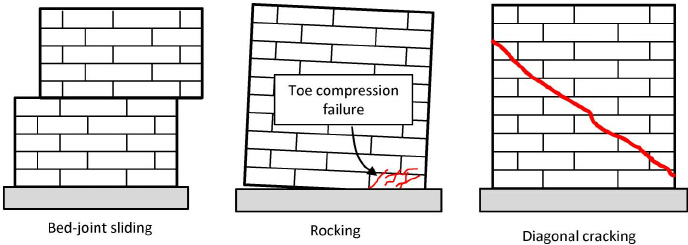Failure Modes of Brick Masonry Buildings

Vibrations caused by earthquakes generate additional loading. Shear stresses develop which cause damage to structural elements. Since masonry, which can be stressed relatively high in compression, is weak in resisting bending and shear, collapse is often the result. The different failures modes of masonry are:
1. Sliding Shear Failure
It results in a building sliding off its foundation or on one of the horizontal mortar joints. It is caused by low vertical load and poor mortar. Suppose the building is adequately anchored to the foundation. In that case, the next concern is for adequate resistance of the foundation itself, in the form of some combination of horizontal sliding friction and lateral earth pressure. The dislocation of a lightly attached roof is also an example of this type of failure. A wall with poor shear strength, loaded predominantly with horizontal forces can exhibit this failure mechanism.
The aspect ratio for such walls is usually 1:1 or less (1:1.5)
Sliding shear failure is a mode where the bricks or mortar in the masonry walls slide past each other horizontally. This failure is caused by the horizontal forces acting on the walls during an earthquake. Insufficient bonding between the bricks or inadequate shear strength in the mortar can contribute to this failure mode.
2. Diagonal Cracks
Diagonal cracks in masonry walls when the tensile stresses, developed in the wall under a combination of vertical and horizontal loads, exceed the tensile strength of the masonry material.
Diagonal cracks often occur in brick masonry buildings during seismic events. These cracks typically form at a 45-degree angle and can be observed on the walls. Diagonal cracks are a result of the tensile stresses induced by the lateral forces acting on the building. They can weaken the structural integrity of the walls and indicate potential instability.
3. Non-Structural Failure
While structural elements of a building should be the prime concern for earthquake resistance, everything in the building's construction should resist forces generated by earthquakes. Nonstructural walls, suspended ceilings, window frames, and fixtures should be secure against movement during shaking actions. Failure here may not lead to building collapse, but it still constitutes a danger for occupants and requires costly replacements or repairs.
Interior partitions, curtain walls, wall finishes, windows, and similar building elements are often subjected during earthquakes to shear stresses, for which they do not have sufficient resistive strength. The most common damage resulting from this is the breakage of window panes and cracks in internal plaster and external rendering. A possible remedy for the former is to isolate the window frames from the surrounding walls by introducing flexible joints; the latter can be avoided by reinforcing the plaster or pre-crack it by introducing control joints (groves).
Nonstructural failure refers to the damage or collapse of non-load-bearing elements within the building, such as partitions, facades, or decorative features. During an earthquake, the shaking can cause these nonstructural elements to detach from the main structure, posing a hazard to occupants and potentially damaging the overall stability of the building.
4. Failure due to Overturning
The critical nature of the overturning effect has much to do with the form of the building's vertical profile. A wall that is too tall or too long compared to its thickness is particularly vulnerable to shaking in its weak direction. Thus the tendency of a wall to topple when pushed in a weak direction can be reduced by limiting its length-to-thickness and height-to-thickness ratios.
Overturning failure occurs when the applied forces cause the building to tilt or rotate around its base. This type of failure is often associated with inadequate foundation design or insufficient resistance to lateral loads. Overturning can lead to partial or complete collapse of the structure if not properly addressed.











